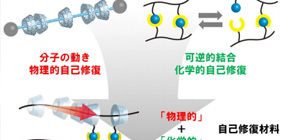
Coating materials with self-healing ability developed
Will lead to commercialization of materials for various products such as coating for cars and hemostatic sheets
As part of a Research Development Program led by Program Manager ITO Kohzo, Impulsing Paradigm Change through Disruptive Technologies Program (ImPACT), Council for Science, Technology and Innovation (CSTI), Cabinet Office, a group of researchers led by Specially Appointed Professor HARADA Akira, developed a self-healing material based on a new design principle.
Two primary design principles have been used for self-healing materials: "physical" self-healing, which used unique properties of materials (such as a dented object returns to its original shape), and "chemical" self-healing (reversible bonds at the molecular level). However, it was difficult for such materials to recover from a scratch mark to its initial state, so self-healing materials based on a new design principle have been sought after in order to solve this problem.
This group developed self-healing materials based on polyrotaxane cross-linked by reversible bond formation between ring molecules and vinyl polymers. After cutting and reattachment, when the solvent is mixed, this material reached 80 percent recovery within 10 minutes, and in the form of solvent-free film, scratches on the surface reached 100 percent recovery within 30 minutes.
The material developed by this group causes a stir in guidelines for designing self-healing materials. Applications in a wide area ranging from chemical products such as coating materials to materials for medical use are anticipated. The guidelines for designing this material can be applied to various types of reverse bonding and have a high degree of freedom for designing, so there is a wide range of possible applications. This group plans to move toward wide range commercialization of this material ranging from chemical products such as coating materials to materials for medical use such as hemostatic sheets.
Abstract
Self-healing materials based on polymer gels composed of polyrotaxane and poly (acrylamide) cross-linked with boronate linkages were synthesized and characterized. These gels combine dynamic covalent bonds with a sliding motion of functional molecules, wherein the mobility of the ring molecules along the axle in the polyrotaxane and the sliding nature of the cross-linker are thought to impart self-healing properties on the resultant materials. Both the gel state and the dried gel state exhibit rapid and efficient self-healing properties. On the basis of the self-healing property of the dried gel, a scratch-healing top coating for hard materials was prepared by a photocuring method. A coating of the self-healing material on glass demonstrates the ability to recover from a scratch mark to its initial state under semi-dry conditions.

Figure 1

Figure 2

Figure 3

Program Manager ITO Kohzo
To learn more about this research, please view the full research report entitled “ Inhaled Fine Particles Induce Alveolar Macrophages Death and Interleukin 1a Release to Promote Inducible Bronchus-Associated Lymphoid Tissue Formation ” at this page of the Immunity website.
Related link
